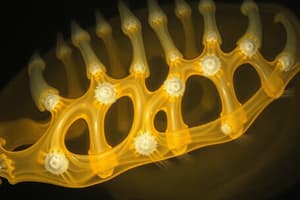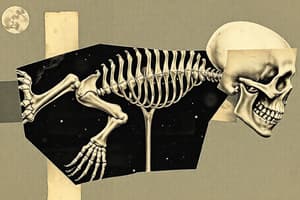Podcast
Questions and Answers
What type of joint allows for free movement in different directions?
What type of joint allows for free movement in different directions?
- Amphiarthrosis
- Fibrous Joint
- Synarthrosis
- Diarthrosis (correct)
Which muscle tissue type is characterized by having multiple nuclei within its cells?
Which muscle tissue type is characterized by having multiple nuclei within its cells?
- Epithelial tissue
- Skeletal muscle (correct)
- Cardiac muscle
- Smooth muscle
What is the primary function of osteoclasts during endochondral ossification?
What is the primary function of osteoclasts during endochondral ossification?
- To resorb bone (correct)
- To produce cartilage
- To anchor muscles
- To form new bone
Which zone in the epiphyseal plate is primarily responsible for cell division and growth?
Which zone in the epiphyseal plate is primarily responsible for cell division and growth?
What covers the surface of bones, except at joints, providing protection and aiding in repair?
What covers the surface of bones, except at joints, providing protection and aiding in repair?
Which cells are primarily responsible for the secretion of bone matrix?
Which cells are primarily responsible for the secretion of bone matrix?
What is the structural classification of epithelial tissues based on?
What is the structural classification of epithelial tissues based on?
What is the primary function of desmosomes in epithelial tissue?
What is the primary function of desmosomes in epithelial tissue?
What type of ossification is responsible for forming long bones?
What type of ossification is responsible for forming long bones?
Which structure allows the diaphysis of long bones to increase in length during growth?
Which structure allows the diaphysis of long bones to increase in length during growth?
What substance helps to secure the periosteum to the underlying bone?
What substance helps to secure the periosteum to the underlying bone?
What is the primary reason epithelial tissues are unique compared to other tissue types?
What is the primary reason epithelial tissues are unique compared to other tissue types?
What type of connective tissue is abundant in lymph nodes and the spleen?
What type of connective tissue is abundant in lymph nodes and the spleen?
What is the primary cause of osteoporosis as mentioned in the context?
What is the primary cause of osteoporosis as mentioned in the context?
Which lifestyle choice is linked to increased risk factors for osteoporosis?
Which lifestyle choice is linked to increased risk factors for osteoporosis?
During endochondral ossification, what initiates the process of calcification within the cartilage model?
During endochondral ossification, what initiates the process of calcification within the cartilage model?
What injury is commonly associated with osteoporosis?
What injury is commonly associated with osteoporosis?
What is a potential treatment strategy for managing osteoporosis?
What is a potential treatment strategy for managing osteoporosis?
At what stage of bone development do secondary ossification centers form?
At what stage of bone development do secondary ossification centers form?
What role do osteoblasts play in endochondral ossification?
What role do osteoblasts play in endochondral ossification?
What is a characteristic difference in osteoporosis risk factors associated with gender?
What is a characteristic difference in osteoporosis risk factors associated with gender?
Flashcards
Bone Matrix Secreting Cells
Bone Matrix Secreting Cells
Osteoblasts are cells that produce and secrete the organic components of bone matrix.
Superficial Skin Layer
Superficial Skin Layer
The epidermis is the outermost layer of the skin.
Tight Junctions
Tight Junctions
Tight junctions form an impermeable barrier between cells, preventing substances from passing between them.
Desmosomes
Desmosomes
Signup and view all the flashcards
Gap Junctions
Gap Junctions
Signup and view all the flashcards
Epithelial Tissue Classification
Epithelial Tissue Classification
Signup and view all the flashcards
Endochondral Ossification
Endochondral Ossification
Signup and view all the flashcards
Intramembranous Ossification
Intramembranous Ossification
Signup and view all the flashcards
Epiphyseal Plate
Epiphyseal Plate
Signup and view all the flashcards
Bone Fracture Types
Bone Fracture Types
Signup and view all the flashcards
Periosteum Inner Layer
Periosteum Inner Layer
Signup and view all the flashcards
Periosteum Attachment
Periosteum Attachment
Signup and view all the flashcards
Epithelial Tissue Avascularity
Epithelial Tissue Avascularity
Signup and view all the flashcards
Reticular Tissue Locations
Reticular Tissue Locations
Signup and view all the flashcards
Liver Macrophages
Liver Macrophages
Signup and view all the flashcards
Most Abundant Body Protein
Most Abundant Body Protein
Signup and view all the flashcards
Bone Thickening
Bone Thickening
Signup and view all the flashcards
Endochondral Ossification
Endochondral Ossification
Signup and view all the flashcards
Chondroblasts
Chondroblasts
Signup and view all the flashcards
Osteoblasts
Osteoblasts
Signup and view all the flashcards
Primary Ossification Center
Primary Ossification Center
Signup and view all the flashcards
Diaphysis
Diaphysis
Signup and view all the flashcards
Epiphyses
Epiphyses
Signup and view all the flashcards
Osteoporosis
Osteoporosis
Signup and view all the flashcards
Bone Reabsorption
Bone Reabsorption
Signup and view all the flashcards
Bone Formation/Deposition
Bone Formation/Deposition
Signup and view all the flashcards
Risk factors of Osteoporosis
Risk factors of Osteoporosis
Signup and view all the flashcards
Osteoporosis injuries
Osteoporosis injuries
Signup and view all the flashcards
Osteoporosis Treatments
Osteoporosis Treatments
Signup and view all the flashcards
Synarthrosis Joint
Synarthrosis Joint
Signup and view all the flashcards
Amphiarthrosis Joint
Amphiarthrosis Joint
Signup and view all the flashcards
Diarthrosis Joint
Diarthrosis Joint
Signup and view all the flashcards
Multinucleated Muscle Type
Multinucleated Muscle Type
Signup and view all the flashcards
Voluntary Muscle Type
Voluntary Muscle Type
Signup and view all the flashcards
Involuntary Muscle Type
Involuntary Muscle Type
Signup and view all the flashcards
Epiphyseal Plate Zones (Resting)
Epiphyseal Plate Zones (Resting)
Signup and view all the flashcards
Epiphyseal Plate Zones (Proliferation)
Epiphyseal Plate Zones (Proliferation)
Signup and view all the flashcards
Epiphyseal Plate Zones (Hypertrophic)
Epiphyseal Plate Zones (Hypertrophic)
Signup and view all the flashcards
Epiphyseal Plate Zones (Calcification)
Epiphyseal Plate Zones (Calcification)
Signup and view all the flashcards
Bone Resorption Cells
Bone Resorption Cells
Signup and view all the flashcards
Medullary Cavity
Medullary Cavity
Signup and view all the flashcards
Spongy Bone
Spongy Bone
Signup and view all the flashcards
Periosteum
Periosteum
Signup and view all the flashcards
Study Notes
Endochondral Ossification
- Mesenchymal cells differentiate into chondroblasts, forming cartilage model
- Osteoblasts form bone collar around diaphysis
- Chondrocytes in center enlarge and calcify, dying to leave calcified matrix
- Blood vessels invade calcified cartilage, bringing osteoblasts to build new bone
- Primary ossification center forms in diaphysis
- Secondary ossification centers form in epiphyses
- Cartilage continues to grow at epiphyseal plates until final bone length
- Osteoblasts and osteoclasts remodel bone throughout life
Osteoporosis
- Decrease in peak bone mass due to excessive bone reabsorption and inadequate new bone formation
- Reduced estrogen increases bone reabsorption
- Decreased calcium metabolism, due to vitamin D deficiency
- Risk factors include caffeine, alcohol, smoking, low calcium intake, being a thin woman
- Causes fractures in lower spine, hip, and wrist
- Treatments include good nutrition, exercise, calcium intake, weight bearing exercises, avoiding smoking, limiting alcohol intake
Connective Tissues
-
Loose Connective Tissues:
- Areolar tissue: Inflammation, strong, looks like a mess
- Adipose tissue: Food fuel, stores heat, looks like cute cells
- Reticular tissue: Supports other cell types, jell-like, has white blood cells
-
Dense Connective Tissues:
- Dense Regular: Attaches muscle to bone, smooth and wavy
- Dense Irregular: Provides strength, wavy in all directions
- Elastic: Allows recoil after stretching, tiny waves
-
Fluid Connective Tissues:
- Blood: Transports
- Lymph: Eliminates stuff
Epithelial Tissues
- Simple Squamous: Diffusion, filtration (lung alveoli, blood vessel linings)
- Stratified Squamous: Protection (skin, mouth, esophagus)
- Simple Cuboidal: Secretion, absorption (kidney tubules, glandular ducts)
- Simple Columnar: Absorption, secretion (stomach, intestines)
- Transitional: Stretches (bladder, uterus)
- Pseudostratified Columnar: Respiratory tract (has cilia, cells are long)
Muscle Tissues
- Skeletal: Striated, long cylindrical, multinucleated, voluntary, attached to skeleton
- Cardiac: Striated, one nucleus, branching, involuntary, intercalated discs (heart)
- Smooth: Non-striated, one nucleus, involuntary, found in hollow organs.
Nervous System
- Neuroglia: Supports and protects neurons
- Neurons: Longest individual cells in the body, extend from spinal cord to toes.
Bone Tissue
- Compact Bone: Contains osteons and perforating canals.
- Osteons: Structural units, contain blood vessels, nerves, and lymphatic vessels
- Lamellae: Concentric rings of bone matrix
- Spongy Bone: lightweight, provides structural support
- Medullary Cavity: Hollow space in diaphysis containing bone marrow
Joints
- Fibrous: No synovial cavity, dense irregular connective tissue (immovable, skull sutures)
- Cartilaginous: No synovial cavity, cartilage (slightly movable, intervertebral discs)
- Synovial: Synovial cavity, dense irregular connective tissue (freely movable, elbow, knee)
- Different joints:
- Hinge: flexion/extension (elbow, knee)
- Pivot: Uniaxial rotation (radioulnar joint, atlantoaxial joint)
- Condylar: Bi-axial (metacarpophalangeal joints)
- Saddle: Bi-axial (carpometacarpal joint of thumb)
- Ball and Socket: Multiaxial (shoulder, hip)
- Plane: Non-axial (intercarpal, intertarsal joints)
Other Information
- Inflammation: Process where damaged area is isolated, damaged cells and foreign invaders are cleaned up. Familiar signs are swelling, redness, warmth, and pain.
- Osteoblasts: Bone-forming cells; contribute to ossification, bone growth and repair
- Osteoclasts: Bone-resorbing cells.
- Epiphyseal plate: Allows for longitudinal bone growth
- Ossification Zones: Resting zone, Proliferation zone, Hypertrophic zone, Calcification zone, Ossification zone (new bone formation)
- Tissue differences: Hyaline cartilage is found before bones are deposited, whereas compact bone contains osteons
- Differences: Epiphysis (ends of long bones and growth plates); Diaphysis (shaft, and contains marrow); Metaphysis (between epiphysis and diaphysis)
- Soft Spots: regions of fibrous connective tissue before bone ossification in infants.
- Medullary Cavity: inner hollow part of long bones.
- Periosteum: Tough connective tissue sheath surrounding bone, with blood vessels and nerves. It is involved in attachment, repair, and bone growth.
Studying That Suits You
Use AI to generate personalized quizzes and flashcards to suit your learning preferences.




